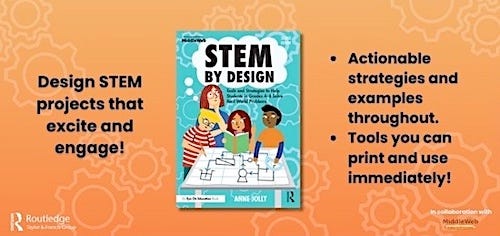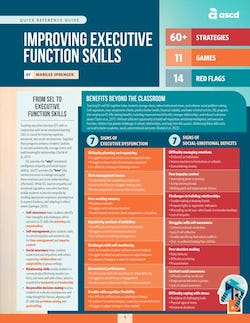Executive Function Games
Marilee Sprenger, the Brain Lady, shares several games that help grow executive function skills and tie them to social-emotional learning.
We’ve promised to begin including some new content in MiddleWeb Substack, to complement our curated topical themes and popular past articles. Here’s our first! (And in case you wonder, this is not a paid ad. We just like the content. :-)
Have you seen those ASCD quick reference guides – the colorful six-pagers they laminate? At MiddleWeb, we sometimes get them in the mail along with review books. They’re not too expensive (about $15) and the topics are interesting.
We asked “the brain lady” – Marilee Sprenger – to share a few of the learning games from her new reference guide Improving Executive Function Skills. It’s literally packed with useful content (”60+ Strategies; 11 Games; 14 Red Flags”) and associated with her recent book The Missing Link to Help Them Think.
As Marilee writes: “When SEL and EF are taught together, students don’t just learn better – they live better… and why not learn through games?”
You’ll find several of her game ideas below. She begins with some stage-setting context. If you’d like to order the guide, you’ll find that information in her bio.
Using Games to Teach Executive Function Skills
By Marilee Sprenger
Perhaps the reason my quick reference guide on improving executive function skills has been so well-received is because it offers information at a glance to help teachers recognize what executive function is, what it isn’t, and what can be done in both the long term and the short term to help students benefit from it. It also includes some EF game ideas. I’ll get to those below. First, some background.
When teachers look at the signs of executive dysfunction, they see themselves. The fact is, we have all suffered executive dysfunction.
For instance, have you ever said anything that you regret? Have you ever forgotten a step in a multi-step process that you are very familiar with or left out an ingredient in a tried and true recipe? Of course you have.
Have you ever failed to see someone else’s point of view? Been resistant to change? Tried the same strategy over and over again and expected a different result? (That’s been referred to as the definition of insanity!) So here we are, teaching our middle school kids the skills they need to succeed, and we are fortunate to have the ability to share with them our own “aha” moments when we, ourselves, have struggled.
Mistakes are data, not disasters! When the end of class arrives you might say to your students: “I didn’t pace this lesson very well, I’ll plan more carefully tomorrow.” And then ask, “When has poor planning happened to you? Write about that on an exit card and leave it on my desk – let’s help each other with time management!”
We need to take advantage of every chance to model good EF skills – and also to tie those skills to social emotional learning. Together, SEL and EF form the bridge between emotion and action, between awareness and achievement. While SEL teaches students to care; executive function shows them how to follow through.
The prefrontal cortex is where emotions meet strategy – and where learning takes flight. Reflection journals, visual schedules, and peer feedback aren’t just good practices – they’re brain-based interventions. Executive function isn’t fixed – it grows with modeling, practice, and support.
“Anne Jolly’s STEM by Design is an accessible and worthwhile read you’ll want to keep handy throughout the year. It’s clearly written and full of actionable advice…a practical guide to designing effective STEM experiences in the middle school classroom.” – Read science teacher Heidi Braden’s complete review.
4 Fun Games That Build SEL and Executive Function
Learning doesn’t have to be all worksheets and lectures – sometimes, the most impactful growth happens during play. Improving Executive Function Skills highlights a set of interactive games that do more than just keep kids engaged – they strengthen essential cognitive and emotional skills. Practice makes powerful.
These games are ideal for most grade levels and create a safe, low-pressure space for students to practice skills like emotional regulation, impulse control, flexible thinking, and empathy. The best part? They’re fun, quick to implement, and require minimal prep. Here are four examples that I’ve expanded for MiddleWeb readers.
1. Emotion Bingo
This twist on the classic game helps students recognize and label emotions. Using cards filled with emotional expressions, kids match them to flashcards or real-life scenarios. It’s an easy way to build emotional vocabulary and boost working memory – while still shouting “Bingo!”
A scenario for emotion bingo: The class is playing Emotion Bingo as a warm-up activity before a lesson on self-awareness and emotional regulation. Each student has a Bingo card (example) filled with various emotions (e.g., embarrassed, excited, nervous, annoyed, proud, disappointed, anxious, joyful).
Teacher reads this scenario aloud:
“Imagine this: You studied really hard for your science test. When you get it back, you see a big red ‘D’ at the top. You glance around and notice your friends got A’s. One of them says, ‘I thought you said you studied!’ The room feels a little too quiet, and suddenly, your face feels hot.”
Teacher prompt:
“Take a moment. Look at your Emotion Bingo card. Which emotion do you think best matches how the student in the scenario might be feeling?”
Follow-up discussion:
“Why did you choose that emotion?”
“Could the student be feeling more than one emotion at the same time?”
“What could the student do next to manage those feelings?”
This scenario targets emotions like embarrassment, disappointment, frustration, or anxiety – perfect for middle schoolers who often face academic pressure and peer comparison. It opens the door to discuss emotional nuance, coping strategies, and social dynamics, all within a low-stakes game.
2. Role-Playing Scenarios
Whether it’s solving a disagreement or learning to wait in line patiently, role-play gives students a chance to walk through real-life challenges in a low-stakes environment. It’s especially powerful for building impulse control, flexibility, and social awareness.
Middle School Role-Playing Scenario: “Group Project Gone Wrong”
Scenario Setup (read aloud by teacher):
You’re working on a group presentation in science class. One person in your group – Jordan – keeps taking charge, interrupting others, and ignoring everyone’s ideas. Maya, another group member, is starting to look frustrated. You feel like no one’s listening to you either, but you’re not sure what to say. The project is due tomorrow, and the tension is rising.
Roles to Assign:
Jordan – the dominating group member
Maya – the frustrated but quiet group member
You – the student trying to find a solution
Observer(s) – students who watch and later offer feedback
Instructions:
Act out a possible version of this group interaction.
Pause mid-scene to ask: “What could be done differently right now?”
Restart the scene and try a new approach that shows empathy, compromise, or leadership.
Reflection Questions:
How did it feel to speak up (or not speak up)?
What helped you stay calm or respectful?
What might you do differently in a real-life situation like this?
This scenario helps middle schoolers rehearse emotionally charged moments they often encounter, giving them a chance to practice regulation, assertive communication, and collaboration – before they’re in the heat of the moment.
3. Story Chain
Gather students in a circle and co-create a story one sentence at a time. Each student adds a new twist, building on what came before. Try using a prompt about a new student or a character facing a social challenge.
This is ideal for building empathy, flexible thinking, listening, creativity, and emotional insight – all while having fun.
Story Chain Scenario: “The New Kid at Lunch”
Teacher reads aloud the story starter:
Today during lunch, you notice a new student sitting alone at the far end of the cafeteria. They’re staring at their tray and picking at their food. You think about going over, but you’re not sure what to say – or what your friends might think. You glance at your table, then back at the new kid.
Instructions:
Each student adds one sentence to continue the story.
Encourage them to build on the previous sentence with emotional awareness and realistic reactions.
Remind them to think about what the characters are feeling, why they might act a certain way, and how their actions could change the outcome.
Example Story Chain in Action:
Student 1: I asked my friends, “Should we invite the new kid to sit with us?” but they just shrugged.
Student 2: I decided to go anyway – I grabbed an extra cookie and walked over to their table.
Student 3: “Hey, I’m Taylor,” I said. “Want to sit with us?”
Student 4: The new student looked up, surprised, and nodded slowly. “Thanks... I’m Kai.”
Student 5: As we walked back, I could feel everyone watching, but I also felt proud.
Student 6: One of my friends made a joke to break the silence, and soon we were all talking – and laughing.
Post-Activity Discussion:
How did Taylor show empathy?
What might Kai have been feeling throughout the story?
Have you ever been in a situation like this?
What other directions could this story have taken?
This activity helps students think critically about peer dynamics, emotional courage, and how small actions can make a big difference.
The Why and the How
There are more games in the guide, along with dozens of strategies to use in your classroom. These games aren’t just downtime fillers – they’re powerful tools for practicing the very skills students need to thrive in school and in life. And because they’re grounded in joy and connection, students are more likely to stay engaged and open to growth.
Remember, SEL gives students the why, and EF gives them the how. These two skill sets, when taught together, provide students with a bridge from emotion to action, and from reaction to reflection. That bridge leads to academic success, healthy relationships, and a resilient, thriving future.
Marilee Sprenger is a veteran educator with more than 25 years of experience teaching elementary, middle, and high school. She’s an author, a professional development specialist, and a popular presenter at conferences and trainings. She specializes in social-emotional learning, executive functioning, memory, vocabulary, and the brain.
Marilee is a member of the American Academy of Neurology and is the author of several publications related to the brain and learning, including the 2025 book The Missing Link to Make Them Think (see Katie Durkin’s review). Visit her website here and browse all of her MiddleWeb articles here.
Learn more about Marilee’s Quick Reference Guide Improving Executive Function Skills at the ASCD/ISTE website. Curious about other ASCD guides? Go here.





Fair. Readers can use what's useful in their work. We welcome other ideas. Post them here!
IMO if this is being targeted to educators the games should be more original. 2/3 of these example games are found in the Zones of Regulation materials with premade faces and scenarios which I think a lot of teachers have seen or used already.